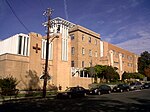Takoma station
1978 establishments in MarylandBuildings and structures in Takoma Park, MarylandFormer Baltimore and Ohio Railroad stationsRailway stations in Montgomery County, MarylandRailway stations in the United States opened in 1978 ... and 4 more
Stations on the Red Line (Washington Metro)Takoma (Washington, D.C.)Use mdy dates from March 2018Washington Metro stations in Washington, D.C.

Takoma is a Washington Metro station on the Red Line in the Takoma neighborhood of Washington, D.C., bordering Takoma Park, Maryland. The station is considered to be located in part of Takoma Park's Historic District. It is the last station in the District of Columbia on the eastern end of the Red Line heading to Maryland, located east of the intersection of Blair Road NW and Cedar Street NW. The station's parking lot and bus stops are accessed from Eastern Avenue NW, which runs along the DC–Maryland line.
Excerpt from the Wikipedia article Takoma station (License: CC BY-SA 3.0, Authors, Images).Takoma station
Spring Place Northwest, Washington Takoma
Geographical coordinates (GPS) Address Website External links Nearby Places Show on map
Geographical coordinates (GPS)
| Latitude | Longitude |
|---|---|
| N 38.975532 ° | E -77.017834 ° |
Address
Takoma
Spring Place Northwest
20012 Washington, Takoma
District of Columbia, United States
Open on Google Maps








